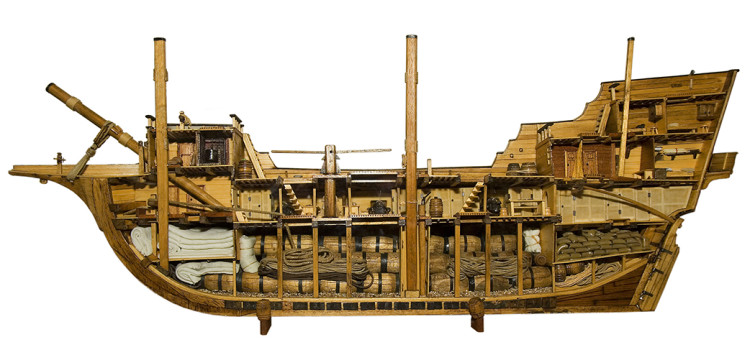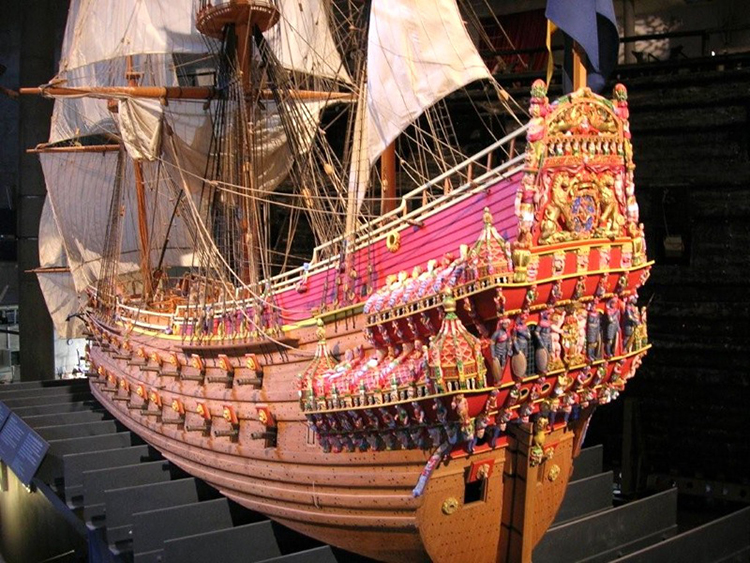AUTHOR DISCLOSURE: I have never lived on a boat. I have never spent more than the 12 or so minutes it took me to get sick to my stomach, on a boat. I know nothing about boats other than I once got on one and was sick within 12-minutes.
Boats are fascinating when it comes to their combination of transportation, domesticity, and labor force. Folks have gravitated to the water for all of history using it for transport, trade, and sport. It is only natural then for us to want to make things that float. A basic raft (a la Tom Sawyer) can be constructed of logs or bundles of reeds tied together. Hollow trunks can be crafted into dugout canoes. In fact, once we, as humans, understood the principle of watertight hulls, we experimented with animal hides and tree bark to attach to a bamboo frame creating a simple, straightforward coracle 1.
If one adds planks to raise the edges of the dugout, and uses wooden struts to secure them in place, the early boatbuilder is well on his way to crafting the only design of wooden boat capable of being built on a large scale. This design then incorporates a keel to which a ribbed frame is added. As the walls continue upward a cargo area is formed and a passenger vessel begins.

It wasn’t until the 5th century onwards that boats turned to ships and ships turned from machines of war to a simple form of transport. The boat has become known in modern times as a Viking longship. By the 11th century the vessels had become more strategic and more elaborate measuring up to 80 feet long, built from oak planks, boasting two high pointed ends, encompassing holes for sixteen oars along each side, and featuring a broad oar that was worked as a rudder by the helmsman. To add to the modernized longship a mast was fashioned near the center on which a long, rectangular sail was hung. What is interesting though is that five boats discovered in the Roskilde Fjord, north of Copenhagen, Denmark, all had similar shapes but also had a double-ended convention in order to support an inclusion of long-range archers (men with bow and arrow). One of the five boats though was built more elaborately and robust than the others including having higher sides and a central hold. These early boats may be examples of of Viking ships that “soldiers”, along with their families and livestock, took on their expeditions to Iceland, Greenland, and perhaps North America.
Do you see where we’re going with this?

As the 15th century set upon us there are rapid developments in nautical life. A second mast is added to sailing vessels and eventually a third mast. By the mid-1400s regular vessel sizes were near 120 feet long and 50 feet wide. The largest European sailing ship (and remember there was nothing tiny in the United States as of yet because Columbus had not even sailed the ocean blue!) of the 15th century is the Spanish carrack which at 1,000 tons becomes the standard vessel of Atlantic trade and adventure into the mid-16th century. Those would soon be trumped though by the oft-ostentatious and gilded merchant ships which needed to be roomy for cargo and strong, presumably to fend off pirates, and comfortable, for the captains and the VIP passengers working hard to secure fortunes in the East. And so it is here that we come to find people living aboard ship. For all intensive and historical purposes the sailing vessel has now turned into a floating living space out of necessity and by design!

1 Wikipedia.
Part 1 of 3 on the legacy of boats to the tiny house world. Stay tuned!
By Andrew M. Odom for the [Tiny House Blog]

I am looking forward to the rest of your article. Short, sweet, interesting.
The merchantman could well qualify as a large tiny house! Great lakes here we come. LOL1
Michael
So glad you enjoyed the article Michael. Boats and the use of space within are a large form of inspiration to tiny houses. Look forward to further posts similar in topic.
Hi,
I had been exploring the idea of a tiny house for a while and was getting ready and still am to move into one. I was ready to purchase a 45 feet container and start working in it but somehow after watching the movie Maidentrip about a 14 year old girl traveling around the world I decided to make my tiny home on a boat and now I am on the market for a 40ft boat!
I’m sorry but I do not see the relevance of this article in relation to tiny houses. There are numerous types of small house boats and rafts that this article could have chosen as a topic but instead it simply mentions a few different types of boats. I don’t mean to sound negative but when there are so many topics relevant to tiny houses I feel that articles like this one seem like filler. Thanks.
No need to apologize Bobbb. You may nave noticed that over the last month or so I have begun writing about ‘Tiny House History.’ While a seemingly mundane topic and one that is largely made up it is my version of how we got to where we are. I do intend to go further into this subject and you will see in future posts some of those small house boats and rafts you mention.
To see where we are going one must first no where we have been.
Please enjoy today’s post and know that it is not at all filler but rather a close examination of how tiny houses have developed from sources other than a trailer company somewhere in the midwest.
Please use some editorial discretion in deciding what articles to publish. I don’t see any similarity between the Royal Navy’s 17th century warship and the myriad issues that I face in constructing an affordable small dwelling.
Stay with us Mike. Stay with us. It will all make sense. Remember, this is part of my ‘Tiny House History’ series.
Anyone planning their own tiny home would do well to look at boat design. Any small vessel going out for more than a couple of days must be a tiny floating home addressing the tasks of working, sleeping, cooking, washing, etc. in a small space for extended periods of time. The website shown here is dedicated to home builders and many boat plans for vessels similar sizes to tiny homes are good examples of using space with folding tables, storage, etc.
http://www.duckworksmagazine.com/
Example of a good use of a small space might be Bolger’s ‘CHAMPLAIN’, look under something like bing images for ‘bolger champlain boat’ and check out the interior. Bolger designs for that size and larger often show great use of space and they are designed for the most part to be owner built.
Don’t waste time reinventing the wheel, do your homework.
Excellent comment David. Excellent. You are so right in that we would all do well (and save time, money, and resources) by understanding that the wheel is out there. We just have to look for it.
Two of the lakes near me (Central California), Huntington ( 7000 feet +-) and Shaver (5000 feet +-), allow you to stay in a houseboat (meeting the local regulations) for free during the late spring to fall. Not only do you miss the Central Valley heat (100+), but if you built your own houseboat it would be a cheap place to live for part of the year. Glen-L Marine sells simple plans.
Good fishing, too, right off your porch.
I could see that being a very satisfying life. Tiny house trailer part of the year. Tiny house boat the other part!
Except that there were actually plenty of tiny houses in America before Christopher Columbus “discovered” it. WIgwams? Teepees? Sod houses? Plank houses? Any of these would certainly qualify as “tiny houses”. 🙂
Absolutely Wendy. And who knows? Maybe those are up next! Stay tuned….
Having lived aboard boats for over 27 years now, all of them which would qualify as “tiny homes,” I am delighted to see you covering the floating tiny home. Boats fit the tiny home trend just as much as RVs and trailerable homes. I have lived on a 24 foot sailboat, a 31 foot sailboat (which we sailed down the west coast to Mexico) and now live on a 32 foot sailboat. We’ve figured (roughly) that we currently live in approximately 168 square feet of space. I love the simplicity of living in a small space and I love being so close to the natural world. Thank you for looking into the tiny home boating community.
Thank you Kim for such a warm comment. I truly appreciate it. My fascination for boat living and understanding them as both form and function grows daily. Your experiences sound awesome!
You confused me. TUGboat I can understand. Tub was interpreted like a bathtub not a boat.
Don’t forget the Phoenicians! And the Chinese treasure fleets.
tiny is as tiny does.. so many people own boats that could be lived aboard but sit empty at the docks of many (all) marinas.. same as rv’s motor homes, campers that also sit idle until the two week vacation roles around. So designs for boats tend to cater to recreation and not long term living.. If you take the houses you have been building on trailers and adapt them to float and form coimmunities (like on the rivers and bayous around New Orleans) or Holland.. that would reveal some great solutions.
Ah, not ALL marinas. There are places in the world where full time boat living flourishes and has for hundreds of years, as well as modern live aboard folks such as the one commenter here who has lived on a boat for 27 years. I know plenty of people who can match that and more, within a 50 mile radius of my own tiny home on land (after years of living aboard).
Looking forward to the next part of this article!
Fascinating! i had to send it to my son who is an old Navy man. He wants to build a boat so badly! Maybe this will encourage him to do so.
I found this very interesting. Looking forward to more. Thank you. : )
Namaste
Loving these history posts, thank you!
I’m completely blown away. I just seen the second part. Sailed away on lake Erie. Thanks.